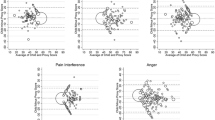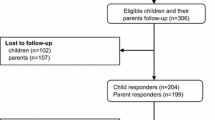Abstract
Aims
There is a need for a brief, validated measure of quality of life (QOL) for children to monitor their adjustment to burn injuries. We aimed to apply a Rasch analysis to an existing measure of QOL from the dermatology literature to a clinical sample of pediatric burn patients.
Methods
The Children’s Dermatology Life Quality Index (CDLQI) was administered to pediatric burn patients (N = 253) during a standard clinic visit. Rasch analysis was used to examine psychometric properties of this measure with a burn sample.
Results
The CDLQI showed an adequate fit to the Rasch model. Test difficulty is .61 logits greater than person ability. Results of item reliability and separation analyses were sufficiently strong and indicated a unidimensional latent trait. Person reliability (.74) and separation analyses (1.64) were moderate. Finally, the CDLQI was able to moderately separate the group of respondents into low and high levels of QOL impairments related to burn injuries.
Conclusion
The Rasch model demonstrated that the CDLQI is a reliable and valid scale that adequately measures QOL impairments in children following burn injuries.

Similar content being viewed by others
References
Gibran, N. S. (2013). Presidential address: Our third leg—we have seen it all before. Journal of Burn Care and Research,34, 1–7. https://doi.org/10.1097/BCR.0b013e31827e4ee9.
Nedelec, B., Donelan, M., Baryza, M., Bhavsar, D., Blome-Eberwein, S., Carrougher, G. J.,… Ware, L. (2013). Functional outcomes. Journal of Burn Care & Research, 34, 376–380
Wilson, I. B., & Cleary, P. D. (1995). Linking clinical variables with health-related quality of life. A conceptual model of patient outcomes. Journal of the American Medical Association,273, 59–65. https://doi.org/10.1001/jama.273.1.59.
Griffiths, C., Armstrong-James, L., White, P., Rumsey, N., Pleat, J., & Harcourt, D. (2015). A systematic review of patient reported outcome measures (PROMs) used in child and adolescent burn research. Burns,41, 212–224. https://doi.org/10.1016/j.burns.2014.07.018.
Wiechman, S., Meyer, W., Edelman, L., Fauerbach, J., Gibbons, L., Holavanahalli, R.,… Yovino, S. (2013). Psychological outcomes. Journal of Burn Care & Research, 34, 363–368
Finlay, A. Y., & Khan, G. K. (1994). Dermatology Life Quality Index (DLQI)—a simple practical measure for routine clinical use. Clinical and Experimental Dermatology,19, 210–216. https://doi.org/10.1111/j.1365-2230.1994.tb01167.x.
Lewis-Jones, M. S., & Finlay, A. Y. (1995). The Children’s Dermatology Life Quality Index (CDLQI): Initial validation and practical use. British Journal of Dermatology,132, 942–949. https://doi.org/10.1111/j.1365-2133.1995.tb16953.x.
Olsen, J. R., Gallacher, J., Finlay, A. Y., Piguet, V., & Fancis, N. A. (2016). Quality of life impact of childhood skin conditions measured using the Children’s Dermatology Life Quality Index (CDLQI): A meta-analysis. British Journal of Dermatology,174, 853–861. https://doi.org/10.1111/bjd.14361.
Mazharinia, N., Aghaei, S., & Shayan, Z. (2007). Dermatology Life Quality Index (DLQI) scores in burn victims after revival. Journal of Burn Care Research,28, 312–317. https://doi.org/10.1097/bcr.0b013e318031a151.
Agaei, S., Sodaifi, M., Jafari, P., Mazharinia, N., & Finlay, A. Y. (2004). DLQI scores in vitiligo: Reliability and validity of the Persian version. BMC Dermatology,4, 8. https://doi.org/10.1186/1471-5945-4-8.
Ryan, C. M., Lee, A. F., Kazis, L. E., Shapiro, G. D., Schneider, J. C., Goverman, J.,… Tompkins, R. G. (2016). Is real-time feedback of burn-specific patient-reported outcome measures in clinical setting practical and useful? A pilot study implementing the young adult burn outcome questionnaire. Journal of Burn Care and Research, 37, 64–74. https://doi.org/10.1097/bcr.0000000000000287
Salek, M. S., Jung, S., Brincat-Ruffini, L. A., MacFarlane, L., Lewi-Jones, M. S., Basra, M. K., et al. (2013). Clinical experience and psychometric properties of the Children’s Dermatology Life Quality Index (CDLQI), 1995–2012. British Journal of Dermatology,169, 734–759. https://doi.org/10.1111/bjd.12437.
Andrich, D. (1978). A rating formulation for ordered response categories. Psychometrika,43, 561–574. https://doi.org/10.1007/bf02293814.
Linacre, J. M. (2018). Winsteps Rasch measurement computer program (Version 4.1.0). Beaverton, OR: Winsteps.com.
Linacre, J. M. (1999). Investigating rating scale category utility. Journal of Outcome Measurement,3, 266–283.
Iramaneerat, C., Smith, E. V., & Smith, R. M. (2008). An introduction to Rasch measurement. In J. W. Osborne (Ed.), Best practices in quantitative methods (pp. 50–70). Thousand Oaks, CA: Sage Publications Inc.
Christensen, K. B., Makransky, G., & Horton, M. (2016). Critical values for Yen’s Q3: Identification of local dependence in the Rasch model using residual correlations. Applied Psychological Measurement,41(3), 178–194.
Bond, T. G., & Fox, C. M. (2007). Applying the Rasch model: Fundamental measurement in the human sciences (2nd ed.). Mahwah, NJ: Lawrence Erlbaum Associates Inc.
Linacre, J. M. (2018b). Winsteps Rasch measurement computer program user’s guide. Beaverton, OR: Winsteps.com. Retrieved 11 Jan 2019, from http://www.winsteps.com/winman
Wright, B. D. (1995). Which standard error? Item specific or general? Ideal or real? Rasch Measurement Transactions,9(2), 436.
Fisher, W. P. (2007). Rating scale instrument quality criteria. Rasch Measurement Transactions,21(1), 1095.
Wright, B. D., & Linacre, J. M. (1994). Reasonable mean-square fit values. Rasch Measurement Transactions,8(3), 370.
DeVillis, R. F. (1991). Scale development: Theory and applications. Newbury Park, CA: Sage.
Nijsten, T., Meads, D. M., de Korte, J., Sampogna, F., Gelfand, J. M., Ongenae, K., et al. (2007). Cross-cultural inequivalence of dermatology-specific health-related quality of life instruments in psoriasis patients. Journal of Investigative Dermatology,127, 2315–2322. https://doi.org/10.1038/sj.jid.5700875.
Author information
Authors and Affiliations
Corresponding author
Additional information
Publisher's Note
Springer Nature remains neutral with regard to jurisdictional claims in published maps and institutional affiliations.
Rights and permissions
About this article
Cite this article
Parrish, C., Haines, R.T., Stewart, D. et al. Assessing child quality of life impairments following pediatric burn injuries: Rasch analysis of the children’s dermatology life quality index. Qual Life Res 29, 1083–1091 (2020). https://doi.org/10.1007/s11136-019-02380-w
Accepted:
Published:
Issue Date:
DOI: https://doi.org/10.1007/s11136-019-02380-w




